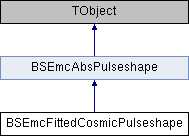Pulseshape of Cosmic signals measured a FwEndcap alveole in the Bonner Teststation.
More...
Pulseshape of Cosmic signals measured a FwEndcap alveole in the Bonner Teststation.
Parameterization started as a as a combination of three sigmoid functions f, g and h The overall form was: y(t) = A f(t) * (R * g(t) + (1-R) h(t)) with A being a measure of the amplitude and R the ration of the falling flanks (slow and fast component) taken from {FRIESEN2020163302, title = {A functional form for liquid scintillator pulse shapes}, journal = {Nuclear Instruments and Methods in Physics Research Section A: Accelerators, Spectrometers, Detectors and Associated Equipment}, volume = {955}, pages = {163302}, year = {2020}, issn = {0168-9002}, doi = {https://doi.org/10.1016/j.nima.2019.163302}, url = {https://www.sciencedirect.com/science/article/pii/S0168900219315505}, author = {F.Q.L. Friesen and C.R. Howell}, keywords = {Neutron, Scintillator, Pulse-shape discrimination, Sigmoid, NE213, BC501A}, abstract = {Digitization of detector signals enables analysis of the original waveform to extract timing, particle identification, and energy deposition information. Here we present the use of analytical functions based on sigmoids to model and fit such pulse shapes from liquid organic scintillators, though the method should also be applicable to other detector systems. Neutron and gamma interactions in NE213 detectors were digitized from the phototube anode and fit using a sigmoid-based function. The acuity of the fit in extracting timing information and performing neutron-gamma pulse-shape discrimination are presented and discussed.} }
However, after playing and fitting around, it was noticed that the form y(t) = A f(t) * g(t) describes the waveform sufficiently.
- Author
- Ben Salisbury salis.nosp@m.bury.nosp@m.@hisk.nosp@m.p.un.nosp@m.i-bon.nosp@m.n.de, HISKP Bonn
Definition at line 43 of file BSEmcFittedCosmicPulseshape.h.



 Public Member Functions inherited from BSEmcAbsPulseshape
Public Member Functions inherited from BSEmcAbsPulseshape